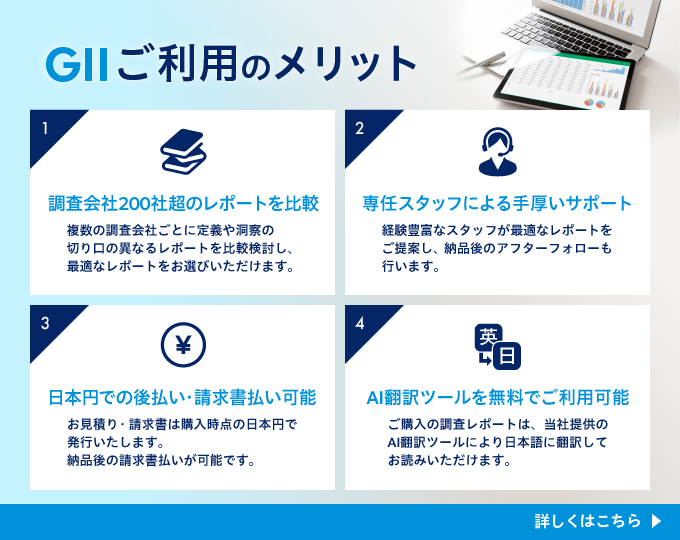
|
市場調査レポート
商品コード
1457934
オーファンドラッグの世界市場における成長機会Global Orphan Drug Growth Opportunities |
||||||
|
|||||||
| オーファンドラッグの世界市場における成長機会 |
|
出版日: 2024年03月01日
発行: Frost & Sullivan
ページ情報: 英文 78 Pages
納期: 即日から翌営業日
|
全表示
- 概要
- 目次
独占権の減少と競合の激化が、より効率的な研究開発とデジタルソリューションの需要を促進
この調査では、Frost & SullivanのTransformational Healthチームが、世界のオーファンドラッグ(OD)業界に関する重要な洞察を提供し、成長機会、収益、規制の変更、成長に影響を与える技術動向を明らかにします。希少疾患(RD)の約5%が米国FDAの医薬品承認を取得している一方で、RDの最大15%は、疾患治療や予防の可能性を示す医薬品が少なくとも1つ存在します。対処されていない希少疾患のニーズが増加していることは、研究開発の大きなきっかけとなっています。現在、治療法の選択肢が限られているRDを治療するために、新規の治療薬が必要です。ビッグデータアナリティクス、マルチオミクス、ナノメディシン、遺伝子編集技術、次世代診断など、精密医療とインフォマティクスの最近の進歩により、RDに対する特異的かつ個別化された治療法を開発する機会が生まれています。がんとRDの融合は明らかになりつつあります。精密腫瘍学と希少腫瘍に対するオーダーメイド医療は、この分野の重要なテーマとして浮上しており、OD業界の拡大を促進しています。
ODの開発には、核酸医薬、遺伝子治療、細胞治療、人工タンパク質など、個別化医療の研究開発の盛り上がりを中心に、さまざまな手法が用いられています。中小企業(SME)がOD薬の半分以上を開発しているのは、科学的支援、承認前後のプロセス、製造販売承認申請にかかる価格が安いというメリットがあるからです。ベンチャーキャピタルからの初期投資がこの勢いを後押ししています。
OD政策により、RDの治療アクセスは改善され、地域および世界の人々に恩恵をもたらしています。こうした行動は、公衆衛生と研究に対する各国のコミットメントを示すものであり、可能性の高いパートナーシップと投資を後押ししています。医療システムは、現在および将来の医療支出を抑制する必要性に直面しています。支払者は、最適な均衡を保証するために、医療費と患者のアクセスレベルを熱心に精査しています。医療プランのスポンサーは、政府がオーファンドラッグ法(Orphan Drug Act)の改正やインフレ削減法(IRA)の影響を考慮する中、次の一手を検討しています。
目次
戦略的インペラティブ
- なぜ成長が難しくなっているのか?
- The Strategic Imperative 8(TM)
- オーファンドラッグ業界に対する主要な戦略的インペラティブの影響
- Growth Pipeline Engine(TM)を促進する成長機会
成長環境
- 分析範囲
- セグメンテーション
- 希少疾患におけるペイシェントジャーニーの課題
- 希少疾患の新薬開発における今後の重要なステップ
- 成長機会
- ベンダー情勢
- 成長促進要因
- 成長抑制要因
成長環境 - パイプライン分析
- パイプライン分析と概要、治療セグメント別
- パイプライン概要、技術タイプ別
地域分析
- 希少疾患の治療開発へのインセンティブ - 地域の概要
- 地域の要約
- 地域の魅力
- 最近の規制政策と取り組み、地域別
- IRAが米国のオーファンドラッグ業界に与える影響
- 医薬品開発における米国FDAの特別指定 - オーファン、ファストトラック、迅速承認、優先審査、画期的な治療法
ビジネスモデルと投資の概要
- ODのビジネスモデル
- M&A評価
- ベンチャー融資の評価
デジタルテクノロジーの導入
- 製薬バリューチェーンにおける持続可能性を促進する市場動向
- デジタルノベルソリューションの応用
- 業界ユースケース - UCBによる重症筋無力症治療薬
成長機会分析
- 調査プロセス・調査手法
- 予測に関する考察
- 成長指標
- 収益予測
- 収益予測分析
- 収益予測、製品タイプ別
- 予測分析 - 低分子
- 予測分析 - 生物学的製剤
- 予測期間中に注目すべき主要資産
- 収益割合の内訳、技術タイプ別
- 収益割合の予測、治療タイプ別
- がんの主要な希少適応症
- 承認された抗がん剤の特徴 - オーファン vs. 非オーファン
- がん以外の主要な適応症 - 免疫/筋骨格系
- がん以外の主要な適応症 - CNS
- 非がん領域の主要適応症 - 血液疾患・代謝性疾患
- 価格動向
- 競合環境
- 収益シェア
- 収益シェア分析
成長機会ユニバース
- 成長機会1:核酸ベースの治療薬
- 成長機会2:医薬品再利用のためのバイオインフォマティクスの活用
- 成長機会3:中東における戦略的パートナーシップで、診断・治療の改善
- 成長機会4:AIの活用による診断・治療の改善
次のステップ
Reduced Exclusivity and Increased Competition will Drive Demand for More Efficient R&D and Digital Solutions
In this study, Frost & Sullivan's Transformational Health team provides critical insights into the global orphan drug (OD) industry and highlights growth opportunities, revenue, regulatory changes, and technology trends influencing growth. Approximately 5% of rare diseases (RDs) have received US FDA approval for a drug, while up to 15% of RDs have at least 1 drug that exhibits potential in terms of disease treatment or prevention. The growing number of unaddressed RD needs is a major catalyst for R&D. There is a need for novel medicine to treat RDs that currently have limited therapeutic choices. Recent advancements in precision medicine and informatics, such as big data analytics, multi-omics, nanomedicine, gene-editing techniques, and next-generation diagnostics, have created opportunities to develop specific and individualized therapies for RDs. The convergence of cancer and RDs is becoming evident. Precision oncology and tailored medicine for rare tumors are emerging as prominent themes in the discipline, facilitating the OD industry's expansion.
Various techniques are used to develop ODs, mainly due to the rise of R&D in personalized medicine, including nucleic acid drugs, gene therapies, cell therapies, and engineered proteins. Small and medium-sized enterprises (SMEs) develop more than half of ODD medication because they benefit from lower prices for scientific assistance, pre- and post-authorization processes, and marketing authorization applications. The early investments obtained from venture capitalists buoy the momentum.
RD treatment access has improved with OD policies, benefiting local and global populations. These actions showcase countries' commitment to public health and research, boosting probable partnerships and investments. Healthcare systems face increasing requirements to contain present and future healthcare spending. Payers are diligently scrutinizing medicine costs and patient access levels to guarantee optimal equilibrium. Healthcare plan sponsors are considering their next move as governments contemplate Orphan Drug Act changes and the impact of the Inflation Reduction Act (IRA).
Key Issues Addressed:
- How much revenue will the global OD industry generate in 2028?
- Which segments will influence revenue growth rate?
- What challenges do patients face in their RD journeys?
- Which business models, technologies, and trends must stakeholders and participants watch during the forecast period?
- What are the major OD growth opportunities?
Table of Contents
Strategic Imperatives
- Why is it Increasingly Difficult to Grow?
- The Strategic Imperative 8™
- The Impact of the Top 3 Strategic Imperatives on the Orphan Drug Industry
- Growth Opportunities Fuel the Growth Pipeline Engine™
Growth Environment
- Scope of Analysis
- Segmentation
- Rare Disease Patient Journey Challenges
- Critical Future Steps in the Development of Novel Drugs for Rare Diseases
- Growth Opportunities
- Vendor Landscape
- Growth Drivers
- Growth Restraints
Growth Environment-Pipeline Analysis
- Pipeline Analysis and Summary by Therapeutic Segment
- Pipeline Summary by Technology Type
Regional Analysis
- Incentives to Develop Treatments for Rare Diseases-A Regional Overview
- Regional Synopsis
- Regional Attractiveness
- Recent Regulatory Policies and Initiatives by Region
- Impact of the IRA on the US Orphan Drugs Industry
- Special US FDA Designations for Drug Development-Orphan, Fast Track, Accelerated Approval, Priority Review, and Breakthrough Therapy
Business Models and Investment Overview
- OD Business Models
- M&A Assessment
- Venture Financing Assessment
Digital Technology Implementation
- Market Trends Advancing Sustainability in the Pharma Value Chain
- Digital Novel Solution Applications
- Industry Use Case-UCB's Drug for Myasthenia Gravis
Growth Opportunity Analysis
- Research Process and Methodology
- Forecast Considerations
- Growth Metrics
- Revenue Forecast
- Revenue Forecast Analysis
- Revenue Forecast by Product Type
- Forecast Analysis-Small Molecules
- Forecast Analysis-Biologics
- Key Assets to Watch During the Forecast Period
- Percent Revenue Breakdown by Technology Type
- Percent Revenue Forecast by Therapy Type
- Key Oncology Rare Indications
- Approved Oncology Drugs' Characteristics-Orphans versus Non-orphans
- Key Non-oncology Indications-Immunology/Musculoskeletal System
- Key Non-oncology Indications-CNS
- Key Non-oncology Indications-Blood Disorders and Cardio-metabolic Diseases
- Pricing Trends
- Competitive Environment
- Revenue Share
- Revenue Share Analysis
Growth Opportunity Universe
- Growth Opportunity 1: Nucleic Acid-based Therapeutics
- Growth Opportunity 2: Leveraging Bioinformatics for Drug Repurposing
- Growth Opportunity 3: Strategic Partnerships in the Middle East to Improve Diagnosis and Treatment
- Growth Opportunity 4: Utilizing AI to Improve Diagnosis and Treatment
Next Steps
- Your Next Steps
- Why Frost, Why Now?
- List of Exhibits
- Legal Disclaimer

